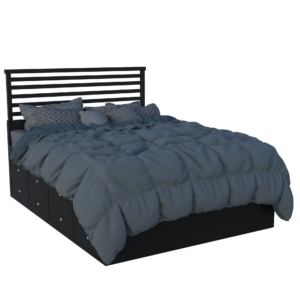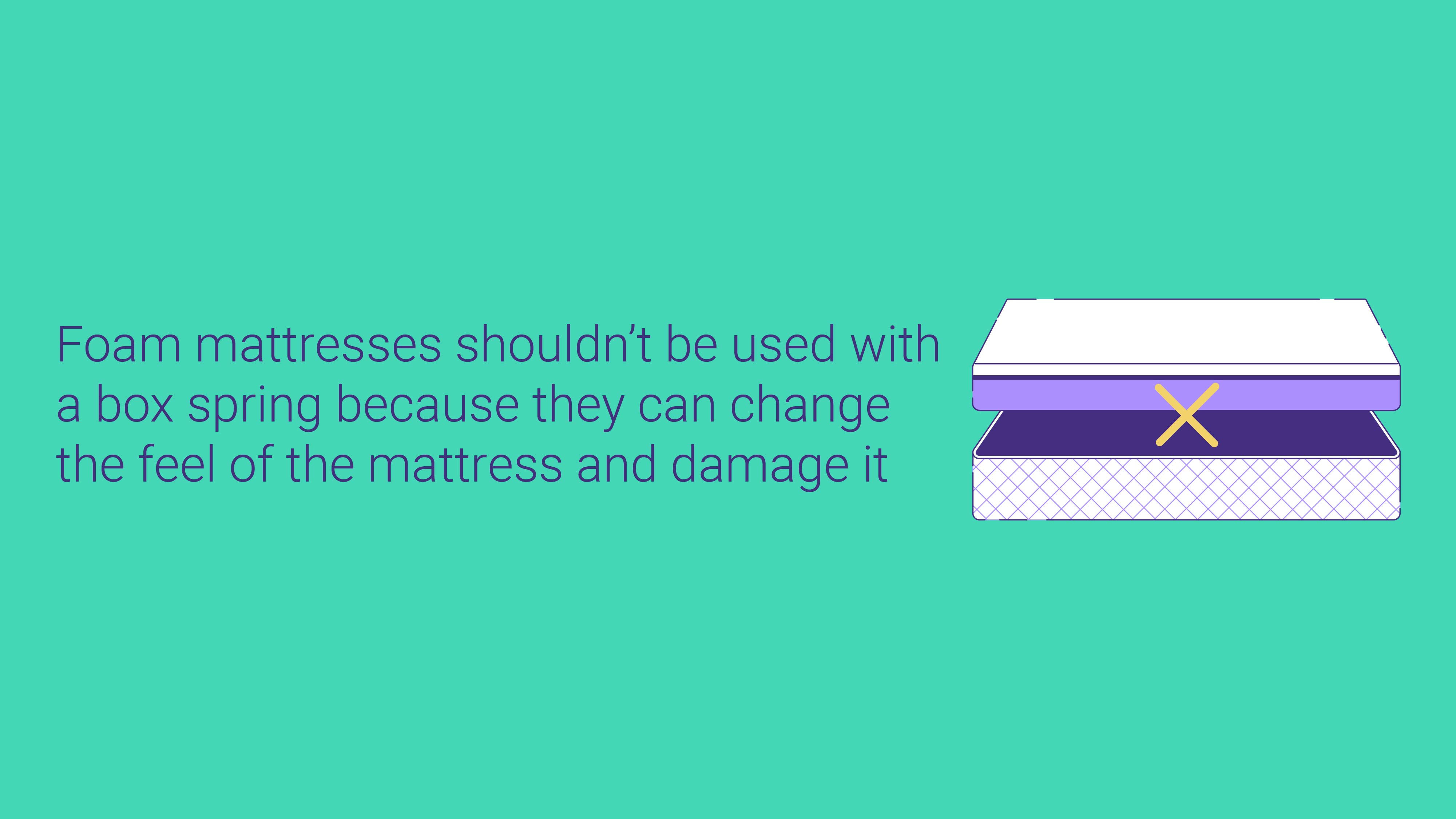
How Often Should You Replace Your Mattress?

- Experts recommend replacing your mattress every 8 years, but factors like weight, mattress construction, and care can influence the lifespan.
- Heavier individuals or those sharing a bed may need a thicker and firmer mattress to prevent sagging. Understanding the firmness scale (1-10) and Indentation Load Deflection (ILD) can help in choosing the right mattress.
- Lack of care, improper foundation use, and mattress construction/materials contribute to deterioration. Use a mattress protector, choose a suitable foundation, and be aware of mattress materials for longevity.
So, your mattress is starting to look a little worse for the wear and you wake up in pain. You feel trapped or stuck in your bed every morning, or maybe it just feels like you’re sleeping on a thin piece of fabric. If this sounds like you, it’s time to replace your mattress, no matter how old it is.
The National Sleep Foundation recommends replacing your mattress every 8 years or so, and most high-quality mattresses should last about that long. However, the time for replacing may come earlier depending on your age, weight, the mattress’ construction, and other factors.
This article will go in-depth about how often you should replace your mattress, as well as other things to consider when you’re ready to buy a newer, better model.
What Causes a Mattress to Sag or Deteriorate?

A few things can accelerate your mattress’ decline, such as weight, improper care, or even using the mattress on an incompatible foundation. Let’s go over a few of the most common things that may be causing your mattress to dip.
Weight, Thickness, and Density
Of course, a mattress is meant to support your weight. Most top-rated mattresses are thick enough to do so, but thinner models (less than 10 inches thick), can be insufficient for heavier weights.
For instance, if you share your bed with a partner or maybe you just roll around a lot while you sleep, your mattress may sag quicker than it normally would. A 12 inch mattress or thicker can often withstand the weight of two people better than a thinner mattress can.
Typically, an adult or child weighing under 150 pounds can sleep comfortably on most mattresses without any issues (as long as they don’t have other special considerations, such as sleeping hot or chronic pain).
Many mattress companies sell more than one mattress, each of them with different features and usually different firmness levels. The most common firmness levels you’ll see are soft, medium, and firm. If you’re shopping online, it’s hard to tell which firmness will suit you best since you don’t get to try out the mattress until it’s arrived at your house.
This is when knowing the ILD, or Indentation Load Deflection, and the firmness scale can help. The ILD number is a measurement mattress companies use to determine how much weight a mattress can withstand before it indents up to one inch or 25% of the mattress thickness. The higher the ILD number, the firmer the mattress. Now, most mattress companies don’t advertise the ILD number of every mattress, but if you’re curious, you can always ask via their contact form or customer service.
However, most brands will advertise the firmness level using some kind of infographic. The “firmness scale” goes from 1-10, with one being very soft and plush, and ten being extremely firm. Most mattresses are between a 3-8 on the scale, since a too soft or firm mattress would be unsupportive and uncomfortable for most sleepers. Typically, a mattress needing to support more weight should be thicker and firmer.
Firmness Scale and Comfort Level:
| Firmness | Best For... |
|---|---|
| Soft (1-2) | Lightweight sleepers or side sleepers |
| Medium-Soft (3-4) | Lightweight or combo sleepers, lightweight couples |
| Medium (5-7) | Most sleepers, including heavyweight, combo sleepers, and couples |
| Firm (8-10) | Stomach sleepers or back sleepers, heavyweight sleepers |
The firmness scale is a great reference, but it is subjective based on the brand. What one company classifies as a medium, another might classify as a medium-soft or medium-firm mattress. This is why you should always utilize sleep trials if possible.
A standard mattress is typically between 10-12 inches thick— a company should always advertise the mattress thickness on its website, and some brands charge more for extra layers. If you want to upgrade to a thicker mattress, make sure your sheets will fit over the top.
If you plan on using a topper with the mattress as well, that will only make it thicker, which can change the feel of the mattress and the fit of your bedding.
Using a mattress that’s too soft or too thin will inevitably lead to premature sagging and damage. Make sure to take all of these things into account before you buy your new mattress.
Lack of Care and Maintenance
Like most things, mattresses reflect the kind of care they get. If you don’t use a durable mattress protector or encasement, you run the risk of staining your mattress permanently or letting dust mites, allergens, dead skin cells, and bed bugs infiltrate it. Any damage to the mattress can and usually does void your warranty, inherently decreasing the mattress’ value.
Waterproof mattress protectors are not very expensive, and most of them are made with noiseless materials now, so you shouldn’t even know the protector is there. Protectors significantly extend the life of your mattress, so we think they’re a worthwhile investment.
Taking other precautions can make your mattress last longer, such as vacuuming the sleeping surface with a hose attachment, spot-cleaning any stains using a gentle cleaning solution, and trying not to eat in bed.
A Flimsy or Improper Foundation
Almost all companies will communicate the best foundation for their mattresses on their website because the foundation is key to maintaining the warranty.

Foam mattresses shouldn’t be used with a box spring because they can change the feel of the mattress and damage it. Box springs were only designed for traditional spring mattresses, so they can’t provide the support a mattress without springs needs.
Always use foam beds on a mattress foundation or platform bed frame with slats no more than 2.75 inches apart or with a single piece of plywood under the mattress. You can even use your foam bed directly on the floor, but this can decrease airflow through the mattress.
If you’re planning on using your mattress with an adjustable bed foundation, foam, latex, and some hybrids are the best mattress types for adjustable frames. Innerspring mattresses aren’t pliable or compressible like some other types, and using them on an adjustable frame can damage them.
A comfortable mattress can help alleviate pressure points, particularly if you choose one of the most comfortable mattresses with materials and a firmness that suits your sleep style. However, even the most comfortable and supportive mattresses can wear out prematurely on improper bases.
We should also note that a mattress lying flat on a bed can offer only a fraction of the benefits best adjustable bed frames can provide. Read our guide to learn more about how adjustable beds can help sleepers control symptoms of various medical conditions and more.
Mattress Construction and Materials
The comfort layers sit right on top of your mattress, and as a result, they take the brunt of the damage you inflict. Comfort layer composition and materials vary across brands, but typically they look like this for different types of mattresses:
Innerspring comfort layer: Innersprings most often utilize polyfoam, foam, or cotton in a quilted pillow top comfort layer. Innerspring mattresses are still some of the most popular mattress types, but they also rank the lowest as far as durability goes.
Hybrid comfort layer: A hybrid mattress is made using 50% foam and 50% coils. The coils are almost always found in the core base layer, and the layers of foam are placed throughout, including at the top. Hybrids most often use memory foam, latex foam, or polyfoam as their top layers.
Memory foam comfort layer: Memory foam mattresses use low-density foams in the comfort layer and higher-density foams in the transition and core layers. The most durable memory foam mattresses should have a high-density foam core that’s thicker than the lower-density foam layers.
Latex foam comfort layer: Latex mattresses usually use aerated latex foam in their top layers and higher density latex foam in the bottom support layers. Latex is one of the most durable materials you’ll find in mattresses, which accounts for the extra cost.
In general, a firmer mattress is more durable than a super plush model because firm mattresses use more high-density foams, while soft models use a higher quantity of lower-density foams. If you prefer a softer feeling mattress, just make sure it has a sturdy support core in the form of high-density foam or steel coils.
When to Replace
How do you know when it’s time to buy a new mattress? If anything in the following list describes your current situation, it may be time to consider a better mattress.
Sleep Deprivation
If you wake up after a full night of sleep feeling unrested, your mattress may be to blame. Poor sleep can lead to other, more serious health issues, such as depression, anxiety, weight gain, heart disease, and more. Everyone deserves a good night’s sleep, so if you think your mattress has lost its support or cushioning, it’s time to buy another and invest in your well-being.
Dust Mites and Bed Bugs
Once dust mites and bed bugs have taken over your mattress, it’s nearly impossible to take it back. Dust mites irritate allergies and exacerbate symptoms of asthma, skin rashes, or breathing issues— all of these problems can interrupt sleep. Bed bugs, on the other hand, are hard to get rid of once they’ve made a new home in your mattress. Once you notice them, it’s time to throw your mattress away.
SEE ALSO: Best Hypoallergenic Mattresses for Allergies
Pain
Waking up in pain can be a sign your mattress is not alleviating pressure points but instead causing inflammation to build up in your hips, spine, back, and more. Your mattress should be a respite from pain at the end of the day.
Your sleeping position affects your posture and overall health, and people with certain sleep preferences should look for a mattress to fit.
Side sleepers are usually most comfortable on a medium feel mattress. Back sleepers most often prefer a medium to medium-firm mattress, and stomach sleepers should look for a medium-firm to firm bed. All sleeping positions need a mattress that keeps the spine neutral and doesn’t misalign anything.
Escaped Fiberglass
Fiberglass has been criticized lately as a mattress material for the way it can irritate the skin, stomach, and lungs. However, usually the material is tucked away within the mattress and can’t come into contact with a sleeper. But if the cover wears down enough to allow the fiberglass particles to leak through, it can cause discomfort. Cleaning up fiberglass is also a tricky task, as the tiny particles need special equipment like a vacuum with a HEPA filter.
Mattresses that have been criticized for their use of fiberglass include:
While you can attain some peace of mind by using a mattress protector to keep the fiberglass from escaping if the cover wears through, it’s best to toss the mattress once you have an active fiberglass leak.
After you’ve tossed the mattress, you can prevent a future occurrence by picking out one of the best mattresses without fiberglass.
How to Extend the Life of Your Mattress
If you notice your mattress is starting to sag or deteriorate and you aren’t ready to buy a new mattress just yet, you can extend its life just a little bit more by using a few tricks. Keep in mind that these are all temporary solutions, and you will eventually need to purchase a new mattress.
Toppers
Lots of people use toppers to make their mattress softer and more comfortable. Some cooling mattress toppers can also make a too hot mattress more comfortable, along with adding a touch of plush cushion.
Mattress toppers can act as a temporary buffer between you and an unsupportive mattress but remember— toppers are not really a long-term solution, and if you’re still waking up with pain, a new mattress may be a better solution.
Flip It!
Some companies make flippable mattresses now, allowing you to switch sides when the side you’re sleeping on doesn’t work anymore. Some flippable mattresses are made with two different firmness levels on either side and so they might not be suitable for everyone.
If your mattress was not marketed as flippable, it should not be flipped. Flipping it will completely change the feel and might cause the materials to sag even faster. You can always rotate your mattress regularly to extend its life.
What to Do with Your Old Mattress
Once you’re ready to upgrade to a new mattress, there are a few things you can do to get rid of your old one. Some people like to keep it as a “backup” bed in a guest room. However, if the mattress is damaged beyond repair, it’s better to donate it or throw it away.
Some mattress companies offer a White Glove Delivery option with the purchase of a new mattress— along with delivering and setting up your new mattress, they will remove your old one. You can also donate your mattress to a local charity— just make sure to contact them beforehand to make sure they don’t have specifications for what can be donated. You can also look into recycling the mattress.
Shop Sales to Save on a New Mattress
If you know you’re likely to need to replace your mattress soon, you can often get a better deal by taking advantage of the next big mattress sale. Some of the best mattress sales of the year include:
- MLK Day Mattress Sales
- Sleep Awareness Week Mattress Sales
- Presidents Day Mattress Sales
- Memorial Day Mattress Sales
- 4th of July Mattress Sales
- Labor Day Mattress Sales
- Columbus Day Mattress Sales
- Black Friday Mattress Sales
- Cyber Monday Mattress Sales
Frequently Asked Questions
How do I know if my bed is worn out?
Ask yourself if you’re still getting a good night’s sleep on your mattress, or if it still looks like it’s in good condition. A mattress that’s sagging or has permanent indentations likely means the bed has lost its support. If you continue to sleep on it, you may find yourself waking up with a bad back.
Other signs that the mattress is losing its shape include lumps and rips. Before you buy a new mattress, you might want to double-check your warranty. Most manufacturers will replace a sagging mattress, but how much the mattress needs to sag to qualify for a replacement varies.
If you find yourself getting a full night’s sleep (which for most adults is 7 to 9 hours) and still wake up tired, it may mean that your mattress is no longer comfortable and supportive enough to help you recover while you rest. And if you wake up and find yourself sneezing or feeling congested, the culprit might be allergens that have built up in your mattress over the years.
Can a mattress last 20 years?
It’s unlikely that a mattress will last for two decades if you sleep on it every night, no matter how high-quality its materials are. Some memory foam and latex mattresses can still provide a comfortable night’s rest after 10 or even 15 years. Most beds don’t last much longer because their parts wear down and allergens might find their way inside the mattress, irritating your senses while you sleep.
What is the best time to buy a mattress?
May is often considered the best month to buy a mattress because many mattress companies release their new models in June. That means mattress stores will be eager to clear out their older stock to make way for the new mattresses. Some of the big mattress sales days include Presidents Day, Memorial Day, the Fourth of July, Labor Day, and Black Friday.
Is it better to sleep on a hard or soft mattress?
The answer depends on your sleeping style and body weight. Heavyweight sleepers (over 230 pounds) and those who sleep on their back or stomach often rest better on firmer mattresses. Side sleepers and people who weigh less than 130 pounds might want to consider a softer bed.
Do you really need a box spring with a new mattress?
Box springs often last longer than a mattress does, with some recommending you replace a box spring every 10 years. However, many modern mattresses no longer require a box spring to feel comfortable. Using a box spring with a foam mattress can even damage the mattress. Foam mattresses need consistent support; when placed on a box spring, they’re prone to sink between the coils and lose their shape.
Are You Ready to Replace Your Mattress?
Your mattress has served you well, but perhaps it’s time to move on— if you’re waking up in pain or you think allergens, dust mites, or bed bugs have taken over your bed, start looking for a new, more comfortable mattress.
